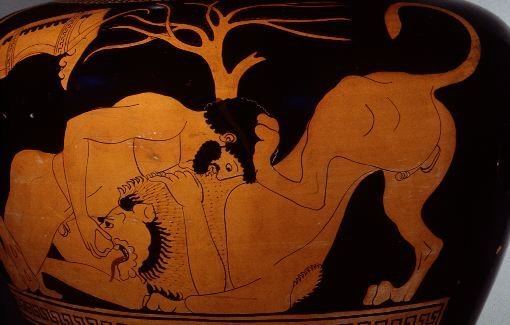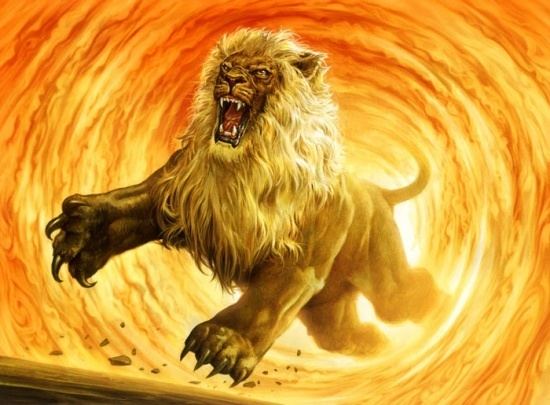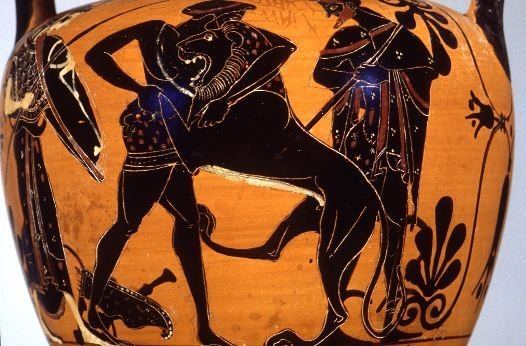 | ||
Similar Heracles, Eurystheus, Augeas, Hippolyta, Alcmene | ||
The Nemean lion (/nɪˈmiːən/; Greek: Νεμέος λέων Neméos léōn; Latin: Leo Nemaeus) was a vicious monster in Greek mythology that lived at Nemea. It was eventually killed by Heracles. It could not be killed with mortals' weapons because its golden fur was impervious to attack. Its claws were sharper than mortals' swords and could cut through any armor.
Contents

Today, lions are not part of the Greek fauna (or the fauna of Europe). However, according to Herodotus, lion populations were extant in Ancient Greece, until around 100 BC when they became extinct.

The lion is usually considered to have been the offspring of Typhon (or Orthrus) and Echidna; it is also said to have fallen from the moon as the offspring of Zeus and Selene, or alternatively born of the Chimera. The Nemean lion was sent to Nemea in the Peloponnesus to terrorize the city.

Pantheon nemean lion eng mythic battles pantheon
First labour of Heracles
The first of Heracles' twelve labours, set by King Eurystheus (his cousin) was to slay the Nemean lion.

According to one version of the myth, the Nemean lion took women as hostages to its lair in a cave near Nemea, luring warriors from nearby towns to save the damsel in distress. After entering the cave, the warrior would see a woman (usually feigning injury) and rush to her side. Once he was close, the woman would turn into a lion and kill the warrior, devouring his remains and giving the bones to Hades.
Heracles wandered the area until he came to the town of Cleonae. There he met a boy who said that if Heracles slew the Nemean lion and returned alive within 30 days, the town would sacrifice a lion to Zeus; but if he did not return within 30 days or he died, the boy would sacrifice himself to Zeus. Another version claims that he met Molorchos, a shepherd who had lost his son to the lion, saying that if he came back within 30 days, a ram would be sacrificed to Zeus. If he did not return within 30 days, it would be sacrificed to the dead Heracles as a mourning offering.
While searching for the lion, Heracles fetched some arrows to use against it, not knowing that its golden fur was impenetrable; when he found the lion and shot at it with his bow, he discovered the fur's protective property when the arrow bounced harmlessly off the creature's thigh. After some time, Heracles made the lion return to his cave. The cave had two entrances, one of which Heracles blocked; he then entered the other. In those dark and close quarters, Heracles stunned the beast with his club and, using his immense strength, strangled it to death. During the fight the lion bit off one of his fingers. Others say that he shot arrows at it, eventually shooting it in the unarmoured mouth.
After slaying the lion, he tried to skin it with a knife from his belt, but failed. He then tried sharpening the knife with a stone and even tried with the stone itself. Finally, Athena, noticing the hero's plight, told Heracles to use one of the lion's own claws to skin the pelt.
When he returned on the thirtieth day carrying the carcass of the lion on his shoulders, King Eurystheus was amazed and terrified. Eurystheus forbade him ever again to enter the city; in future he was to display the fruits of his labours outside the city gates. Eurystheus warned him that the tasks set for him would become increasingly difficult. He then sent Heracles off to complete his next quest, which was to destroy the Lernaean Hydra.
The Nemean lion's coat was impervious to the elements and all but the most powerful weapons. Others say that Heracles' armour was, in fact, the hide of the lion of Cithaeron.
According to some authors, Heracles was helped in this labour by an Earth-born serpent, which followed him to Thebes and settled down in Aulis. It was later identified as the water snake which devoured the sparrows and was turned into stone in the prophecy about the Trojan War.
